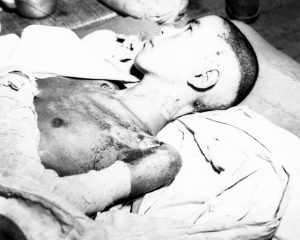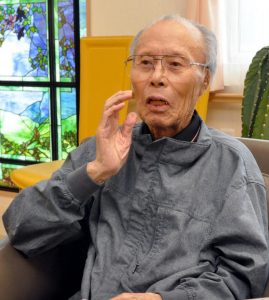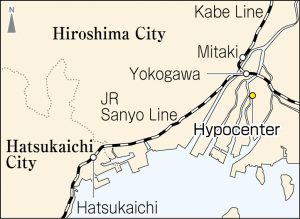Striving to fill voids in Hiroshima, evidence of victims remains—Photos taken by U.S., Part 5: Bedridden young man
Nov. 4, 2022
Photo can serve role of continuing to convey suffering
by Yuji Yamamoto, Staff Writer, and Kyosuke Mizukawa, Senior Staff Writer
“That young man in the photo is me,” explained Kenji Kawamoto, 95, who now lives in a nursing home in Shunan City in Yamaguchi Prefecture, to the Chugoku Shimbun journalist who was paying him a visit. The photograph shows a young man lying down in what appears to be great pain with burns on his upper body and bandages wrapped around his left arm. The photo represents one of the images taken by the United States Strategic Bombing Survey team, which engaged in surveys of the A-bombed Hiroshima. When Mr. Kawamoto saw the same photo in the Chugoku Shimbun for the first time 43 years ago, he came forward to identify himself as the person in the photo.
Mr. Kawamoto was 18 years old at the time of the atomic bombing, on August 6, 1945, and working for the Hiroshima Railway Bureau. That day, he experienced the atomic bombing while digging an air-raid shelter in front of the Yokogawa train station (in Hiroshima’s present-day Nishi Ward), located 1.5 kilometers from the hypocenter. At the moment an intense light flashed, he was blown over by the A-bomb’s blast, his body going stiff. The skin on his shoulder and hands were peeled off from the blast’s thermal rays and hung from his body, blood gushing from his wounds.
He was unable to move without the help of his fellow workers. After reaching the Mitaki medical clinic of the Hiroshima Army Hospital (in Hiroshima’s present-day Naka Ward), he was carried on a stretcher back to the Yokogawa Station and taken on an aid train to a clinic of the Railway Hospital in the area once known as Hatsukaichi-cho (now Hatsukaichi City). He was only half conscious due to a high fever and extreme pain. He turned speechless when he finally got a look at himself in the mirror.
Felt miserable after being photographed
He remembers being ushered to a separate room in the hospital at the end of October after being told to participate in the U.S. military’s survey. An interpreter asked him in broken Japanese how he felt about the United States, and he exploded in resentment. “I aim to take my revenge on those who did this to me.” Just at that time, a camera’s flash bulb lit up. He felt miserable after being photographed.
He survived despite being certain he would die. Even after being released from the hospital at the end of that year, he continued to be bedridden. He was able to return back to work two years after the atomic bombing, but his keloids caused severe pain, which prevented him from working for a long time. He felt unsightly and as a result tried to avoid the attention of other people as much as possible, even by bathing with the light off at the company dormitory after everyone else had finished.
It was then that he decided to work at his own pace and quit his job. In 1979, while managing a restaurant in the present-day Shunan City, he opened the newspaper and saw a photo of a bedridden young man. The youth’s burns looked similar to the scars he saw on his own body every day. He shivered as he thought, “That’s me.”
He immediately contacted the Chugoku Shimbun after initially hesitating to avoid trouble for others if the young man in the photo turned out to be someone else. However, with an article in the newspaper naming him as the person in the photo, a woman in the same hospital room with him after the atomic bombing testified that the youth might have been Mr. Kawamoto, strengthening his resolve.
Nevertheless, voids remain in terms of information to back up the record of events. The photo is said to have been taken between September 1945 and March 1946. According to the medical report compiled by the survey team in 1947, the photo caption reads “Y.T. 19 years old.” Although the timing is consistent with his memory, the initials of the subject and age are different from his own. Mr. Kawamoto assumes it was because the interpreter’s Japanese was insufficient.
Photo used as material for lawsuit
The photo that Mr. Kawamoto attests shows him has occupied an indispensable presence in his life afterwards since he began calling attention to his own persistent anguish and pain. He applied for recognition as suffering from diseases related to the atomic bombing from Japan’s national government but he rejected three times. In 2007, he participated in a class-action lawsuit seeking recognition from the government. In the documents related to the lawsuit, he touched on the photo. The plaintiffs of the lawsuit were successful in the initial trial, in 2009.
In 2012, in his personal history written with the help of a supporter, the same photo was introduced to readers. Until several years ago, he would travel to Hiroshima in August and share his experiences in the atomic bombing with the photo at his side as he communicated the terror of nuclear weapons.
In his mid-90s Mr. Kawamoto has been in a nursing home since last year, 2021. “Nuclear weapons should never again be used. I want that photo to last forever.” He believes the photo will continue to play a role in communicating to others the physical and psychological suffering caused by the atomic bombing.
The devastated city, the pain of victims having to live after being burned in the bombing, and the survivors’ hardship after experiencing the atomic bombing. Even though the photo was taken by the United States, the country that dropped the atomic bomb, it is possible to see in the photo the inhumane nature of nuclear weapons from the standpoint of the A-bombed city. Despite appeals from A-bomb survivors, the fear of nuclear weapons being used again is on the rise. Using the photo is now more important than ever to convey that reality to the world.
(Originally published on November 4, 2022)










